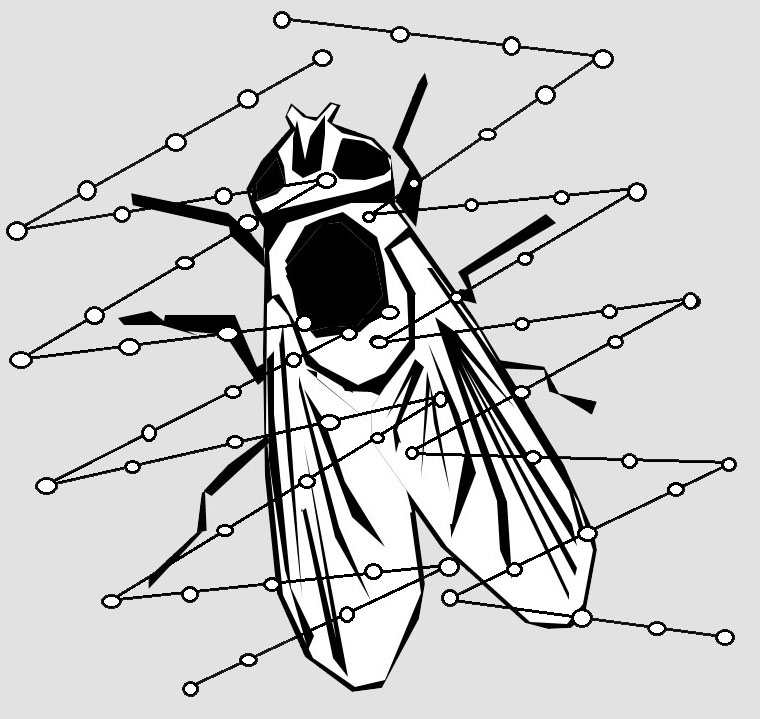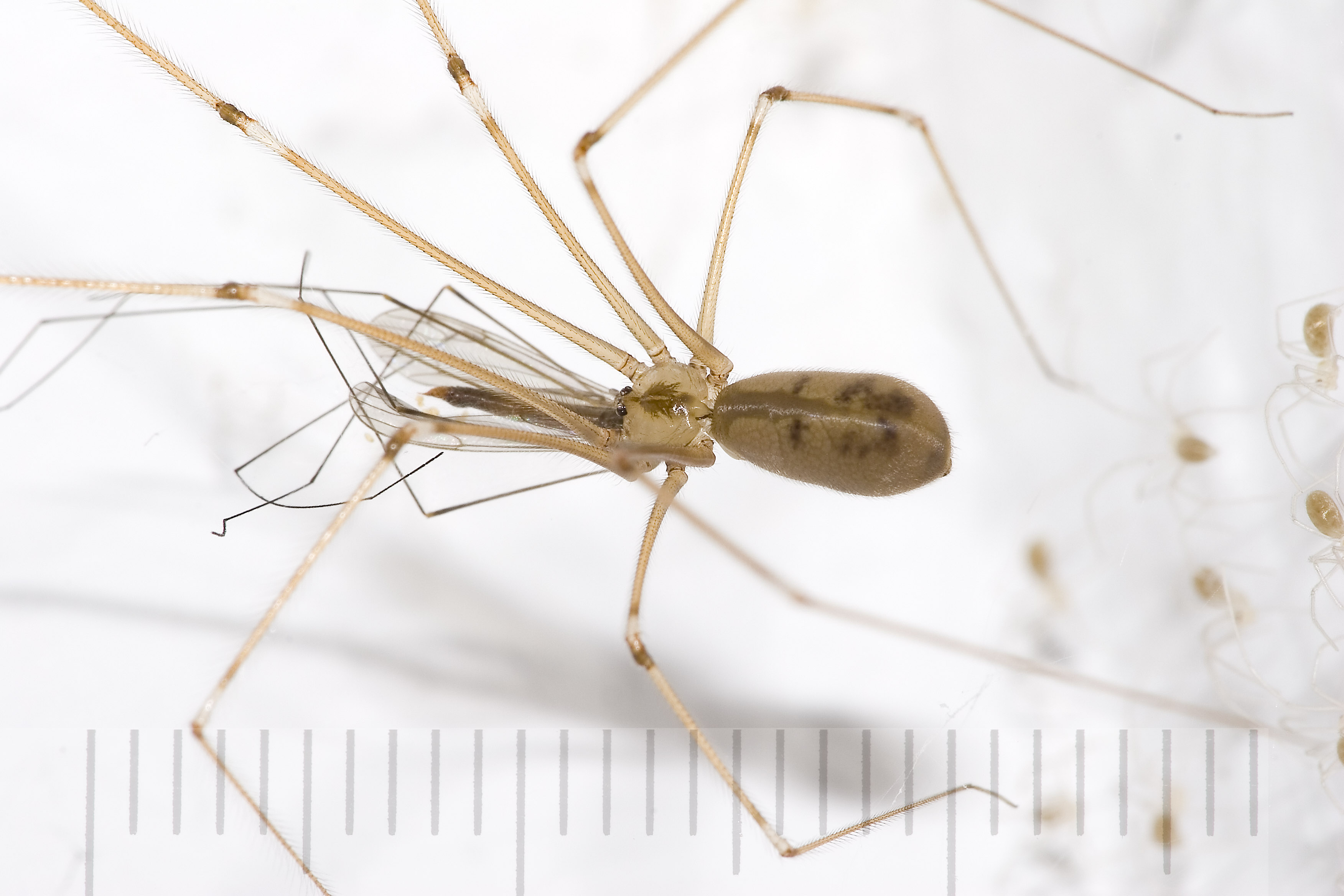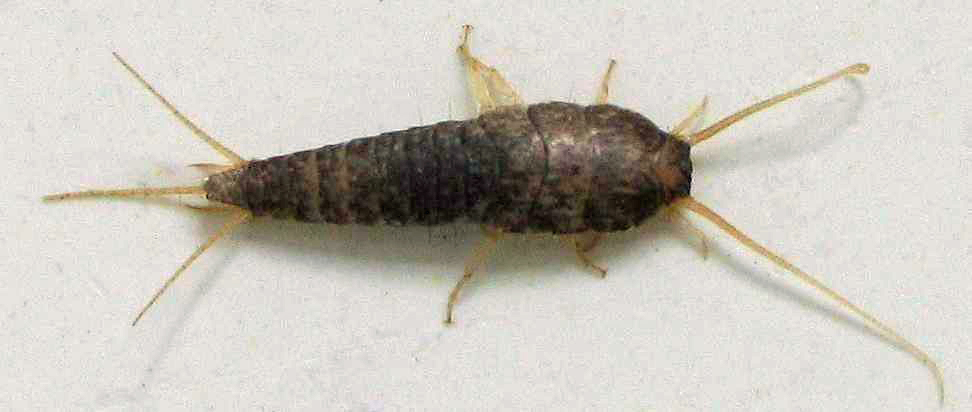|
Spitting Spider
Spitting spiders (Scytodidae) is a family of Araneomorphae, araneomorph spiders first described by John Blackwall in 1864. It contains over 250 species in five genus, genera, of which ''Scytodes'' is the best-known. Description Like Sicariidae, recluse spiders and Diguetidae, coneweb spiders, they have six compound eye, eyes arranged in three pairs and are haplogyne, meaning they have less complex female genitalia. They differ from these families in having a dome-shaped carapace and in their characteristic flecked pattern of spots. Hunting technique Scytodidae catch their prey by spitting a fluid that congeals on contact into a venom (poison), venomous and sticky mass. The fluid contains both venom and spider silk in liquid form, though it is produced in venom glands in the chelicerae. The venom-laced silk both immobilizes and envenoms prey such as silverfish. In high-speed footage the spiders can be observed swaying from side to side as they "spit", catching the prey in a criss- ... [...More Info...] [...Related Items...] OR: [Wikipedia] [Google] [Baidu] |
Scytodes Thoracica
''Scytodes thoracica'' is a spitting spider, so called because it spits a venomous sticky silken substance over its prey. Its size ranges between . The carapace is unusual in sloping upwards towards its rear end, whereas the abdomen slopes downwards. It has six eyes instead of the eight spiders usually have. It has a wide distribution: found in "Europe, North Africa, Turkey, temperate Asia to China, Korea, Japan. Introduced to North America, Argentina, India, Australia, New Zealand." This particular spitting spider features the presence of silk glands in its cephalothorax. Besides the silk glands in its abdomen, the spider also has silk glands connected with its venom glands. In this way the spider has the ability to make venomous silk. Other Arachnida, arachnids may also have silk glands in their cephalothorax, such as the pseudoscorpions. Hunting tactics In contrast to the pseudoscorpions that use the silk from the cephalothorax glands to make nests, the spitting spider uses ... [...More Info...] [...Related Items...] OR: [Wikipedia] [Google] [Baidu] |
Haplogyne
The Haplogynae or haplogynes are one of the two main groups into which araneomorph spiders have traditionally been divided, the other being the Entelegynae. Morphological phylogenetic studies suggested that the Haplogynae formed a clade; more recent molecular phylogenetic studies refute this, although many of the ecribellate haplogynes do appear to form a clade, Synspermiata. Unlike the Entelegynae, haplogynes lack hardened (sclerotized) female genitalia (epigynes). Most of the species within this group have six eyes, as opposed to most other spiders. Spiders in the genus '' Tetrablemma'' (Tetrablemmidae) have only four eyes, as do some members of the family Caponiidae; caponiids may even have only two eyes. However, spiders in the family Plectreuridae have the normal eight eyes. Phylogeny The Haplogynae are one of the two major groups into which araneomorph spiders were traditionally divided, the other being the Entelegynae. In 2005, Coddington summarized the relationships of ... [...More Info...] [...Related Items...] OR: [Wikipedia] [Google] [Baidu] |
Soeuria
''Soeuria'' is a monotypic genus of Seychelloise spitting spiders containing the single species, ''Soeuria soeur''. It was first described by Michael I. Saaristo in 1997, and is found on the Seychelles. See also * List of Scytodidae species This page lists all described species of the spider family Scytodidae accepted by the World Spider Catalog : ''Dictis'' ''Dictis'' L. Koch, 1872 * '' D. denticulata'' Dankittipakul & Singtripop, 2010 — Thailand * '' D. elongata'' Dankittipaku ... References Monotypic Araneomorphae genera Scytodidae Spiders of Africa {{Araneomorphae-stub ... [...More Info...] [...Related Items...] OR: [Wikipedia] [Google] [Baidu] |
Scyloxes
''Scyloxes'' is a monotypic genus of Tajikistani spitting spiders containing the single species, ''Scyloxes asiatica''. It was first described by P. M. Dunin in 1992, and is found in Tajikistan. See also * List of Scytodidae species This page lists all described species of the spider family Scytodidae accepted by the World Spider Catalog : ''Dictis'' ''Dictis'' L. Koch, 1872 * '' D. denticulata'' Dankittipakul & Singtripop, 2010 — Thailand * '' D. elongata'' Dankittipaku ... References Monotypic Araneomorphae genera Scytodidae Spiders of Asia {{Araneomorphae-stub ... [...More Info...] [...Related Items...] OR: [Wikipedia] [Google] [Baidu] |
Dictis
''Dictis'' is a genus of Scytodidae, spitting spiders that was first described by Ludwig Carl Christian Koch in 1872. Species it contains four species, found in Asia, Oceania, North America and Seychelles: *''Dictis elongata'' Dankittipakul & Singtripop, 2010 – Thailand *''Dictis soeur'' (Saaristo, 1997) – Seychelles *''Dictis striatipes'' L. Koch, 1872 (Type_species, type) – Yemen, United Arab Emirates, Iran, tropical Asia, Korea, Japan, China to Australia, Pacific Isles. Introduced to USA, Mexico *''Dictis thailandica'' Dankittipakul & Singtripop, 2010 – Thailand See also * List of Scytodidae species References Araneomorphae genera Scytodidae Spiders of Asia Spiders of Australia Taxa named by Ludwig Carl Christian Koch {{Araneomorphae-stub ... [...More Info...] [...Related Items...] OR: [Wikipedia] [Google] [Baidu] |
World Spider Catalog
The World Spider Catalog (WSC) is an online searchable database concerned with spider taxonomy. It aims to list all accepted families, genera and species, as well as provide access to the related taxonomic literature. The WSC began as a series of individual web pages in 2000, created by Norman I. Platnick of the American Museum of Natural History. After Platnick's retirement in 2014, the Natural History Museum of Bern (Switzerland) took over the catalog, converting it to a relational database. , 50,151 accepted species were listed. The order Araneae Spiders (order Araneae) are air-breathing arthropods that have eight legs, chelicerae with fangs generally able to inject venom, and spinnerets that extrude silk. They are the largest order of arachnids and rank seventh in total species dive ... (spiders) has the seventh-most species of all orders. The existence of the World Spider Catalog makes spiders the largest taxon with an online listing that is updated regularly. It ha ... [...More Info...] [...Related Items...] OR: [Wikipedia] [Google] [Baidu] |
Sociality
Sociality is the degree to which individuals in an animal population tend to associate in social groups (gregariousness) and form cooperative societies. Sociality is a survival response to evolutionary pressures. For example, when a mother wasp stays near her larvae in the nest, parasites are less likely to eat the larvae. Biologists suspect that pressures from parasites and other predators Natural selection, selected this behavior in wasps of the Family (biology), family Vespidae. This wasp behaviour evidences the most fundamental characteristic of animal sociality: parental investment. Parental investment is any expenditure of resources (time, energy, social capital) to benefit one's offspring. Parental investment detracts from a parent's capacity to invest in future reproduction and aid to Family, kin (including other offspring). An animal that cares for its young but shows no other sociality traits is said to be ''subsocial''. An animal that exhibits a high degree of social ... [...More Info...] [...Related Items...] OR: [Wikipedia] [Google] [Baidu] |
Silverfish
The silverfish (''Lepisma saccharinum'') is a species of small, primitive, wingless insect in the order Zygentoma (formerly Thysanura). Its common name derives from the insect's silvery light grey colour, combined with the fish-like appearance of its movements. The scientific name (''L. saccharinum'') indicates that the silverfish's diet consists of carbohydrates such as sugar or starches. While the common name ''silverfish'' is used throughout the global literature to refer to various species of Zygentoma, the Entomological Society of America restricts use of the term solely for ''Lepisma saccharinum''. Description The silverfish is a nocturnal insect typically long. Its abdomen tapers at the end, giving it a fish-like appearance. The newly hatched are whitish, but develop a greyish hue and metallic shine as they get older. It has two long cerci and one terminal filament at the tip of the abdomen between the cerci. It also has two small compound eyes, although other mem ... [...More Info...] [...Related Items...] OR: [Wikipedia] [Google] [Baidu] |
Chelicerae
The chelicerae () are the mouthparts of the subphylum Chelicerata, an arthropod group that includes arachnids, horseshoe crabs, and sea spiders. Commonly referred to as "jaws", chelicerae may be shaped as either articulated fangs, or similarly to pincers. Some chelicerae, such as those found on nearly all spiders, are hollow and contain (or are connected to) venom glands, and are used to inject venom into prey or a perceived threat. In ''Pisaurina mira'', also known as the nursery web spider, the chelicerae are utilized to snatch the prey once it becomes within reach, facilitating the "sit-and-wait ambush predator" behavior. Both pseudoscorpions and harvestmen have structures on their chelicerae that are used for grooming (papillae in pseudoscorpions, cheliceral teeth in Opiliones). Types Chelicerae can be divided into three kinds: jackknife chelicerae, scissor chelicerae, and 3-segmented chelate chelicerae. Jackknife chelicerae The jackknife chelicera is subchelate (with ... [...More Info...] [...Related Items...] OR: [Wikipedia] [Google] [Baidu] |
Spider Silk
Spider silk is a protein fibre spun by spiders. Spiders use their silk to make Spider web, webs or other structures, which function as sticky nets to catch other animals, or as nests or cocoons to protect their offspring, or to wrap up prey. They can also use their silk to suspend themselves, to Ballooning (spider), float through the air, or to glide away from predators. Most spiders vary the thickness and stickiness of their silk for different uses. In some cases, spiders may even use silk as a source of food. While methods have been developed to collect silk from a spider by force, it is difficult to gather silk from many spiders compared to silk-spinning organisms such as Sericulture, silkworms. All spiders produce silk, and even in non-web building spiders, silk is intimately tied to courtship and mating. Silk produced by females provides a transmission channel for male vibratory courtship signals, while webs and draglines provide a substrate for female sex pheromones. O ... [...More Info...] [...Related Items...] OR: [Wikipedia] [Google] [Baidu] |
Venom (poison)
Venom or zootoxin is a type of toxin produced by an animal that is actively delivered through a wound by means of a bite, sting, or similar action. The toxin is delivered through a specially evolved ''venom apparatus'', such as fangs or a stinger, in a process called envenomation. Venom is often distinguished from poison, which is a toxin that is passively delivered by being ingested, inhaled, or absorbed through the skin, and toxungen, which is actively transferred to the external surface of another animal via a physical delivery mechanism. Venom has evolved in terrestrial and marine environments and in a wide variety of animals: both predators and prey, and both vertebrates and invertebrates. Venoms kill through the action of at least four major classes of toxin, namely necrotoxins and cytotoxins, which kill cells; neurotoxins, which affect nervous systems; myotoxins, which damage muscles; and haemotoxins, which disrupt blood clotting. Venomous animals cause tens of thousa ... [...More Info...] [...Related Items...] OR: [Wikipedia] [Google] [Baidu] |
Compound Eye
A compound eye is a visual organ found in arthropods such as insects and crustaceans. It may consist of thousands of ommatidia, which are tiny independent photoreception units that consist of a cornea, lens, and photoreceptor cells which distinguish brightness and color. The image perceived by this arthropod eye is a combination of inputs from the numerous ommatidia, which are oriented to point in slightly different directions. Compared with single-aperture eyes, compound eyes have poor image resolution; however, they possess a very large view angle and the ability to detect fast movement and, in some cases, the polarization of light. Because a compound eye is made up of a collection of ommatidia, each with its own lens, light will enter each ommatidium instead of using a single entrance point. The individual light receptors behind each lens are then turned on and off due to a series of changes in the light intensity during movement or when an object in moving, creating a flic ... [...More Info...] [...Related Items...] OR: [Wikipedia] [Google] [Baidu] |








